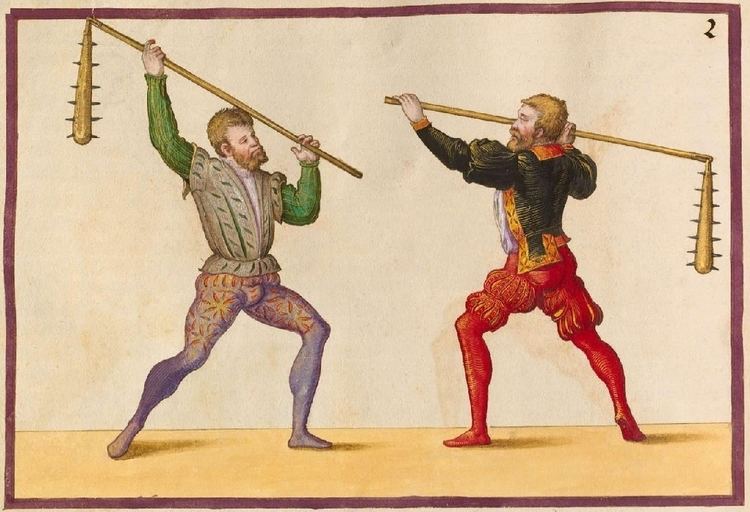 | ||
The term flail refers to two different weapons: a long, two-handed infantry weapon with a cylindrical head, and a shorter weapon with a round metal striking head. The defining characteristic of both is that they involve a separate striking head attached to a handle by a flexible rope, strap, or chain. The chief tactical virtue of the flail was its capacity to strike around a defender's shield or parry. Its chief liability was a lack of precision and the difficulty of using it in close combat, or closely ranked formations.
Contents
The longer cylindrical-headed flail is a hand weapon derived from the agricultural tool of the same name, commonly used in threshing. It was primarily considered a peasant's weapon, and while not common, they were deployed in Germany and Central Europe in the later Late Middle Ages. The smaller, more spherical-headed flail appears to be even less common; it appears occasionally in artwork from the 15th century onward, but many historians have expressed doubts that it ever saw use as an actual military weapon.
The peasant flail
In the Late Middle Ages, a particular type of flail appears in several works being used as a weapon, which consists of a very long shaft with a hinged, roughly cylindrical striking end. In most cases these are two-handed agricultural flails, which were sometimes employed as an improvised weapon by peasant armies conscripted into military service or engaged in popular uprisings. For example, in the 1420-1497 period, the Hussites fielded large numbers of peasant foot soldiers armed with this type of flail.
Some of these weapons featured anti-personnel studs or spikes embedded in the striking end, or are shown being used by armored knights, suggesting they were made or at least modified specifically to be used as weapons. Such modified flails were used in the German Peasants' War in the early 16th century. Several German martial arts manuals or Fechtbücher from the 15th, 16th and 17th century feature illustrations and lessons on how to use the peasant flail (with or without spikes) or how to defend against it when attacked.
The ball-and-chain flail
The other type of European flail is a shorter weapon consisting of a wooden haft connected by a chain, rope, or leather to one or more roughly spherical striking ends. Modern works variously refer to this particular weapon as a "military flail," "mace-and-chain" or "chain mace," and sometimes erroneously label them as simply a "mace" or morning star, terms which technically apply only to rigid weapons. Some historians refer to this weapon as a kettenmorgenstern ("chain morning star") to distinguish it from the rigid weapon.
The haft is usually shown as approximately 1–4 feet long and the head can be a smooth metal sphere or a somewhat geometric shape, with some variants covered in spikes. The chain also varies, sometimes being no more than a few links to form a hinge, while others exceed the length of the haft and are several feet long. Artwork from the 15th century to the early 17th century shows most of these weapons having handles longer than 3 ft and being wielded with two hands, but a few are shown used in a single hand or with a haft too short to be used two-handed.
Despite being very common in fictional works such as cartoons, films and role-playing games as the "quintessential medieval weapon," historical information about this type of flail is somewhat scarce. A few doubt they existed at all due to the number of pieces sitting in museums that turned out to be forgeries, as well as the unrealistic way they are depicted in art. Archaeologically, however, a type of military flail known as a kisten, with a non-spiked head and a leather, rather than chain, connection to the haft is attested in the 10th century in the territories of the Rus, probably being adopted from the either the Avars or Khazars. This weapon had spread into central and eastern Europe in the 11th - 13th centuries and may be considered an ancestor of the ball-and-chain flail. Waldman (2005) documented several seemingly authentic examples of the ball-and-chain flail from private collections as well as several restored illustrations from German, French, and Czech sources. He states that the scarcity of artifacts and artistic depictions, combined with the almost complete lack of text references, suggests they were relatively rare weapons and never saw widespread use. One of the reasons was the hazard the weapon posed to its wielder, especially the varieties with long chains and short handles. A missed swing would still retain momentum, causing the striking end to continue its arc around, potentially into the user's hand or body. A miss could also throw the user off balance, and even if a blow were struck, there would be a dangerously long recovery time before the user could ready another swing or defend himself.
Variations outside of Europe
In Asia, short agricultural flails originally employed in threshing rice were adapted into weapons such as the nunchaku or three-section staff. In China a very similar weapon to the long-handled peasant flail is known as the Two-section staff, and Korea has a weapon called a pyeongon. In Japan, there is also a version of the smaller ball-on-a-chain flail called a chigiriki.
In the 18th and 19th centuries, the long-handled flail is found in use in India. An example held in the Pitt Rivers Museum has a wooden ball-shaped head studded with iron spikes. Another in the Royal Armouries collection has two spiked iron balls attached by separate chains.
